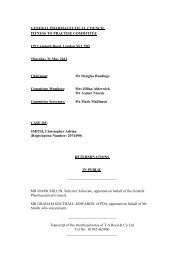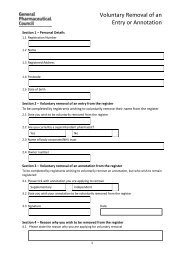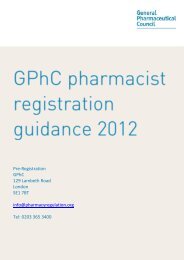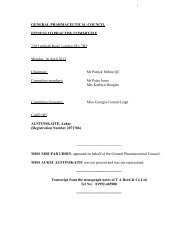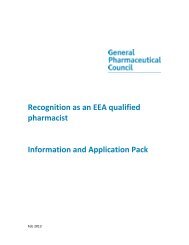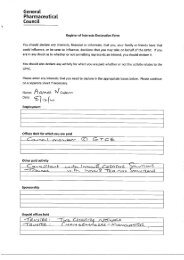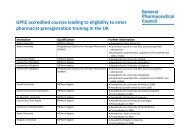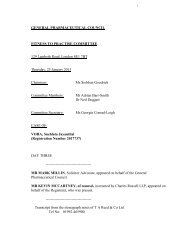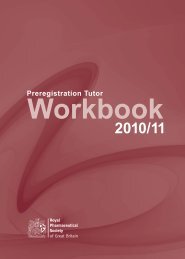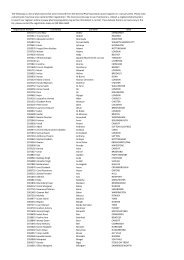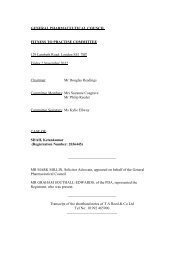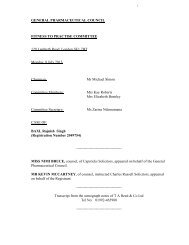Reaccreditation 2011/12 - General Pharmaceutical Council
Reaccreditation 2011/12 - General Pharmaceutical Council
Reaccreditation 2011/12 - General Pharmaceutical Council
Create successful ePaper yourself
Turn your PDF publications into a flip-book with our unique Google optimized e-Paper software.
<strong>Reaccreditation</strong> of an Overseas Pharmacists’ Assessment Programme<br />
(OSPAP)<br />
University of Brighton<br />
Report of a reaccreditation event, 26‐28 June 20<strong>12</strong><br />
Introduction<br />
The <strong>General</strong> <strong>Pharmaceutical</strong> <strong>Council</strong> (GPhC) is the statutory regulator for pharmacists and pharmacy technicians and is the accrediting body for pharmacy education in<br />
Great Britain. The GPhC is responsible for setting standards and approving education and training courses which form part of the pathway towards registration for<br />
pharmacists. The UK qualification required as part of the pathway to registration for pharmacists who have qualified overseas (non‐EEA) is a GPhC‐accredited Overseas<br />
Pharmacists’ Assessment Programme (OSPAP), which is a one‐year post graduate diploma. The GPhC’s right to check the standards of pharmacy qualifications leading to<br />
annotation and registration as a pharmacist is the Pharmacy Order 2010. It requires the GPhC to ‘approve’ courses by appointing ‘visitors’ (accreditors) to report to the<br />
GPhC’s <strong>Council</strong> on the ‘nature, content and quality’ of education as well as ‘any other matters’ the <strong>Council</strong> may require.<br />
This accreditation event was carried out in accordance with the GPhC’s <strong>2011</strong> OSPAP Accreditation Methodology and the course was reviewed against the GPhC’s <strong>2011</strong><br />
education standards ‘Standards for the education and training of non‐EEA Pharmacists wanting to register in Great Britain.’<br />
Background<br />
The University of Brighton OSPAP course was initially accredited by the then regulator, the Royal pharmaceutical Society of Great Britain (RPSGB) in 2005, with<br />
subsequent re‐accreditations in 2006 and 2009. As a result of the 2009 visit the then accreditation team agreed to recommend to the Education Committee of the<br />
RPSGB that the University’s OSPAP course be reaccredited for a full period of 3 years. There was one recommendation, namely that the course team consider whether or<br />
not the assessment for Advanced Drug Delivery was optimal.<br />
<strong>General</strong> <strong>Pharmaceutical</strong> <strong>Council</strong>, OSPAP reaccreditation report<br />
University of Brighton, 26-28 June 20<strong>12</strong><br />
1
Documentation<br />
The provider submitted submission documentation to the GPhC in line with agreed timescales and a pre‐visit took place at the University on 14 May 20<strong>12</strong>. During the<br />
pre‐visit the schedule of meetings and timings for the reaccreditation event were confirmed.<br />
The following documents were submitted by the university in advance of the event:<br />
• Completed GPhC submission template ‘<strong>Reaccreditation</strong> of an OSPAP’ inc. module descriptors and staff CVs<br />
• Course monitoring and evaluation report 2008‐09<br />
• Compact disk of evidence.<br />
The following documents were submitted during the event:<br />
- Reflective diaries for health promotion exercise<br />
- Medicines Use Reviews – did they meet their expectations?<br />
- Sample examination scripts<br />
- 2 x publications on pharmacy teaching<br />
- Module Handbook – Applied Therapeutics<br />
- Coursework on patient interviews<br />
The event<br />
The event began with a private meeting of the accreditation team and GPhC representatives on 26 June 20<strong>12</strong>. The remainder of the event took place on site at the<br />
University of Brighton on 26 June 20<strong>12</strong>, and comprised a series of meetings with staff and OSPAP students of the University and included a tour of the University<br />
facilities.<br />
<strong>General</strong> <strong>Pharmaceutical</strong> <strong>Council</strong>, OSPAP reaccreditation report<br />
University of Brighton, 26-28 June 20<strong>12</strong><br />
2
Accreditation team<br />
The GPhC’s accreditation team (‘the team’) comprised:<br />
Name Designation at the time of accreditation event<br />
Mrs Linda Stone* Accreditation team leader, Pharmacy consultant, community pharmacy background<br />
Prof Brenda Costall Accreditation team member (Academic), Professor of Neuropharmacology, former Head of School, University of Bradford<br />
Prof Larry Gifford Accreditation team member (Academic), Professor of Pharmacy Education, Keele University<br />
Mr Surinder Bassan Accreditation team member (Pharmacist),Chief Pharmacist, Southampton University Hospitals<br />
Mr Alan Kershaw Accreditation team member (Lay), Chair of ILEX Professional Standards Ltd<br />
along with:<br />
Name Designation at the time of visit<br />
Ms Joanne Martin Quality Assurance Manager (Education), <strong>General</strong> <strong>Pharmaceutical</strong> <strong>Council</strong><br />
Mr Hugh Simpson Director of Policy and Communications, <strong>General</strong> <strong>Pharmaceutical</strong> <strong>Council</strong> (28 June only ‐ observer)<br />
Dr Ian Marshall Rapporteur, Emeritus professor of pharmacology, University of Strathclyde<br />
*attended pre‐visit meeting on 14 May 20<strong>12</strong>.<br />
Declaration of potential conflicts of interest<br />
No potential conflicts of interest were declared.<br />
<strong>General</strong> <strong>Pharmaceutical</strong> <strong>Council</strong>, OSPAP reaccreditation report<br />
University of Brighton, 26-28 June 20<strong>12</strong><br />
3
Meeting the accreditation standards<br />
Standard 1 – Patient and public<br />
safety<br />
There must be clear procedures to<br />
address concerns about patient safety<br />
arising from initial pharmacy education<br />
and training. Concerns must be<br />
addressed immediately.<br />
Standard 2 – Monitoring, review<br />
and evaluation of an OSPAP<br />
The quality of pharmacy education and<br />
training must be monitored, reviewed<br />
and evaluated in a systematic and<br />
developmental way.<br />
<strong>General</strong> <strong>Pharmaceutical</strong> <strong>Council</strong>, OSPAP reaccreditation report<br />
University of Brighton, 26-28 June 20<strong>12</strong><br />
Accreditation team’s commentary<br />
The team was confident that the one criterion to meet this standard will be met.<br />
The team was told that the avoidance and reporting of unsafe practice will be dealt with in the simulated pharmacy sessions<br />
in which students will be required to maintain a log book and reflect on any unsafe practices. Students maintain a portfolio<br />
which, if problems do arise, allows the student to express themselves in the portfolio and discuss issues with tutors. OSPAP<br />
students were said to find the ethics teaching challenging due to cultural differences although students interviewed<br />
appeared comfortable with the UK interpretation of ethics. The team was told that OSPAP students receive lectures on<br />
whistleblowing. The team was told that there was a very variable response from students to the concept of fitness to<br />
practise, a fact that the accreditation team confirmed during the meeting with students. The team was told that a solicitor<br />
gives examples of real‐life scenarios in which pharmacists have run foul of disciplinary issues. It was also stated that the<br />
sequelae of dispensing errors are discussed in the dispensing classes.<br />
The team was told that the hospital placement is supervised by the School’s hospital teacher‐practitioners who are academic<br />
team members. For community pharmacy placements the team was told that 2 staff members are members of the LPF and<br />
therefore have contact with local community pharmacists. There is a placement officer who will visit pharmacies that the<br />
School selects; such pharmacies will receive all the learning materials that the students have to complete. However,<br />
pharmacies that are selected by students themselves do not receive information or support from the School. The<br />
accreditation team, although agreeing that the arrangement satisfied the relevant criterion, also agreed that the<br />
arrangement represented a weak element of the OSPAP provision.<br />
The team was confident that the one criterion to meet this standard will be met.<br />
The accreditation team was told that the OSPAP course leader reports to the team leader for pharmacy practice who holds a<br />
budget for postgraduate taught provisions. Strategic issues would be discussed at the School Management Group and<br />
strategic funding could be applied for through this group or directly from the Faculty or University initiatives. The course<br />
leader was content with the resources available for the OSPAP course.<br />
The team was told that although there is stakeholder input to the School’s pharmacy provision overall, there is no specific<br />
stakeholder input into the OSPAP course. The School confirmed that it has a large complement of patients available for<br />
student contact and that these patients do not differentiate between OSPAP and undergraduate students in terms of attitude<br />
and behaviour.<br />
4
Standard 3 – Equality, diversity and<br />
fairness<br />
OSPAPs must be based on principles of<br />
equality, diversity and fairness. It must<br />
meet the requirements of all relevant<br />
legislation.<br />
Standard 4 – Selection of students<br />
Selection processes must be open, fair<br />
and comply with relevant legislation.<br />
Processes must ensure that students are<br />
fit to practice at the point of selection.<br />
Selection includes admissions.<br />
Standard 5 – Curriculum delivery<br />
and Student experience<br />
<strong>General</strong> <strong>Pharmaceutical</strong> <strong>Council</strong>, OSPAP reaccreditation report<br />
University of Brighton, 26-28 June 20<strong>12</strong><br />
The team noted from the documentation that OSPAP students are expected to organise their own community pharmacy<br />
placements. As many of the students work in pharmacies, such pharmacies, although often not local or known to the School,<br />
are usually chosen for the placement experience. Although the School supplies the students with reflective forms to help<br />
them ask questions during the placement, the School representatives admitted that the placement experiences were likely to<br />
be very different. The School attempts to achieve some standardisation through preferring placements where the providers<br />
already have pre‐registration students. The accreditation team, although agreeing that the arrangement satisfied the<br />
relevant criterion, also agreed that the arrangement represented a weak element of the OSPAP provision. The School intends<br />
to use the simulated pharmacy process, an in‐house replication of a busy community pharmacy, to provide appropriate<br />
community pharmacy experience, an idea that emanated from the pre‐visit.<br />
The team was confident that the two criteria to meet this standard will be met.<br />
The team noted from the documentation that the University’s policy on equality and diversity dated from 2009 and therefore<br />
did not encompass the demands of the Equality Act (2010). The team was told that the University equality and diversity team<br />
is currently updating the documentation. It was confirmed to the team that equality and diversity training is mandatory for<br />
all staff. The team was told that the OSPAP students represent a very multicultural group with a range of different beliefs.<br />
This was described as a source of enrichment for the School.<br />
The team was confident that the three criteria to meet this standard will be met.<br />
Applicants have to pass an on‐line calculations test, not have any indicators of inappropriate behaviour as evidenced by a<br />
police report from their own country (or a CRB check if based in the UK) and sign a fitness to practise declaration. The<br />
difficulty for the School in guaranteeing the identity of applicants taking the on‐line calculations test was described. The team<br />
was told that the School compares the result of the on‐line test with that achieved in the diagnostic calculations test in the<br />
induction week. The team learned that applicants have been rejected on the basis of the on‐line calculations test and was<br />
assured that this would continue to be the policy even if applicant numbers fell. The team was told that the School did not<br />
anticipate receiving requests for recognition of prior learning, but it was said that theoretically it would be possible for a<br />
student wishing to transfer from another UK OSPAP course to be considered for the Brighton course.<br />
The team was confident that the twelve criteria to meet this standard will be met.<br />
The team was told that the OSPAP represents a part of an MSc Pharmacy (OSPAP) degree course. Students undertake the<br />
PGDip for the OSPAP qualification and then perform a research project over the summer months to achieve the MSc degree.<br />
This arrangement is designed to overcome the current visa restrictions experienced by overseas students. The arrangement<br />
5
The curriculum for OSPAPs must deliver<br />
the outcomes in Standard 10. Most<br />
importantly, curricula must ensure that<br />
students practice safely and effectively.<br />
To ensure this, pass criteria must<br />
describe safe and effective practice.<br />
<strong>General</strong> <strong>Pharmaceutical</strong> <strong>Council</strong>, OSPAP reaccreditation report<br />
University of Brighton, 26-28 June 20<strong>12</strong><br />
has the disadvantage of OSPAP students graduating later than MPharm students and hence having to commence pre‐<br />
registration training late. The team emphasised to the School that the GPhC was concerned only with the OSPAP (PGDip)<br />
element of the programme and would require that students were awarded this qualification in addition to the MSc degree.<br />
The team was told that the University organises an international orientation week that OSPAP students are encouraged to<br />
attend. Students interviewed who had attended had found the programme very useful. Although the general orientation<br />
week is optional, the School OSPAP induction week is mandatory.<br />
The teaching and learning week is divided into independent learning (from Monday to Wednesday inclusive) and formal face‐<br />
to‐face teaching, with lectures on Thursdays and workshops on Fridays. Students interviewed told the team that although<br />
they had been attracted by the 2‐day contact time structure of the course, hence reducing travel costs, they had found it<br />
extremely demanding. The independent learning period includes modules on the scientific basis of pharmacy practice with 5<br />
domains: chemistry, applied physiology and pharmacology, microbiology, nutrition and research methods and ethics, all with<br />
tutorial support. Placements (half days in both community and hospital) also take place in the independent learning segment<br />
of the provision. The Friday sessions will include first aid, physical examination, the use of the simulated pharmacy, and<br />
interprofessional learning consisting of problem‐based learning with physiotherapy, occupational therapy and podiatry<br />
students. The accreditation team explored the integration of the programme in two separate subgroup sessions, science to<br />
practice, and practice from science. Both subgroups agreed that science and practice were well‐integrated in the<br />
programme.<br />
The team was told that the teaching and learning strategy used a variety of delivery methods, including lectures, group work,<br />
independent learning, and interprofessional learning to match different learning styles. It was stated that the School was<br />
aware of the Standard 10 learning outcomes and attempts to develop more challenging material as the course progresses.<br />
This will involve the demonstration of appropriate relevance and level. There will be a strong emphasis on group work to<br />
encourage peer support and feedback. An innovation was a presentation on the place of psychology in pharmacy education<br />
in which the application of psychology to the achievement of several of the outcomes in Standard 10 was highlighted.<br />
The team was told that the hospital placement takes place in a podiatry clinic at Leaf Hospital in which OSPAP students get<br />
the opportunity to talk to and interview patients, upon which they are required to produce a pharmaceutical care plan which<br />
forms an assessed part of their portfolio. In the community placement OSPAP students write a reflective piece on their<br />
experience in the pharmacy, with emphasis on team work, attributes of the pharmacist and SOPs. The teaching team<br />
admitted that the community pharmacy placement was a variable experience for the students and in future will not be<br />
assessed, community pharmacy experience being dealt with in the simulated pharmacy environment in the University.<br />
The team was told that a range of assessment tools is used for the OSPAP course, their use depending on the learning<br />
6
Standard 6 – Support and<br />
development for students<br />
Students must be supported to develop<br />
as learners and professionals during<br />
their OSPAP<br />
Standard 7 – Support and<br />
development for academic staff<br />
Anyone delivering an OSPAP should be<br />
supported to develop in their<br />
professional roles.<br />
<strong>General</strong> <strong>Pharmaceutical</strong> <strong>Council</strong>, OSPAP reaccreditation report<br />
University of Brighton, 26-28 June 20<strong>12</strong><br />
outcome being tested. The team’s examination of the learning outcomes in Standard 10 gave it confidence that appropriate<br />
assessment methods were being used. The team was told that outcomes at the “know how” level are examined by MCQs and<br />
written questions, whereas “shows how” outcomes are tested by OSCEs, the reflective learning log and presentations. The<br />
teaching team stated that pass marks reflect safe practice and that there are “red flag” elements in the assessments. Causing<br />
potential harm to a patient will lead to failure of, for example, an individual OSCE station. The failure would be discussed by<br />
the module team and would lead to failure of the entire OSCE. The pass mark for each station is at the “minimal level for a<br />
pass” and students must “show how” in order to achieve a pass. Students may re‐sit the OSCE up to a maximum of 3<br />
attempts. Performance in dispensing is assessed by making judgements around patient safety. Students receive feedback on<br />
their performance in practice sessions. Questions from past papers of the registration examination are used in formative<br />
calculations tests. Students are required to achieve 90% and may take the tests repeatedly until the 90% is achieved.<br />
The team was told that the University’s recruitment strategy aims to recruit REF‐suitable staff but that it was paramount that<br />
staff with professional experience was appointed particularly with respect to pharmacy practice. It was stated that 90% of<br />
the practice staff is research‐active. Students interviewed confirmed that members of the teaching staff speak<br />
enthusiastically about their research during their teaching.<br />
The team was confident that the one criterion to meet this standard will be met.<br />
Students interviewed told the team that staff members were easy to contact and provided timely responses to queries. All<br />
staff members were described as friendly, approachable and giving strong support to students. Students were content with<br />
the on‐line feedback from assignments plus timely back‐up feedback from tutors. Tutors were said to explain why answers<br />
were wrong rather than simply giving the correct answer.<br />
Students described an on‐line survey and feedback exercise that they had undertaken. It appeared that there was not a<br />
formal staff‐student liaison committee for OSPAP students but had attended one meeting to discuss the course; they opined<br />
that further meetings would have been useful.<br />
The team was confident that the three criteria to meet this standard will be met.<br />
The team was told that there is a short, fast‐track teaching course for new teachers as well as the University’s PGCertEd. The<br />
latter course was said to contain much material pertaining to cultural differences. The University also has an MA degree in<br />
education for experienced teachers; one of the staff is currently taking this course. There is also a staff development<br />
programme that includes tuition on Turnitin, MCQs, PowerPoint etc. There is a University generic workload model and the<br />
School’s average contact time for staff members is around <strong>12</strong>5‐130 hours per year. It was confirmed that part‐time staff are<br />
eligible to undertake the University’s PGCertEd teaching course and that there is also a shorter fast‐track teaching course<br />
7
Standard 8 – Management of an<br />
OSPAP<br />
An OSPAP must be planned and<br />
maintained through transparent<br />
processes which must show who is<br />
responsible for what.<br />
Standard 9‐ Resources and capacity<br />
Resources and capacity are sufficient to<br />
deliver outcomes.<br />
<strong>General</strong> <strong>Pharmaceutical</strong> <strong>Council</strong>, OSPAP reaccreditation report<br />
University of Brighton, 26-28 June 20<strong>12</strong><br />
available. The teaching team emphasised that teaching the OSPAP course is very different from teaching an undergraduate<br />
course as much of the course involves team‐teaching and the OSPAP students are confident and ask many questions.<br />
The team was confident that the one criterion to meet this standard will be met.<br />
The team noted that the course requires two days per week attendance by students on Thursdays and Fridays. Thursdays are<br />
devoted to lectures and it is University policy that attendance at lectures is not mandatory; as a result no record of<br />
attendance is maintained. Fridays consist of tutorial/workshop teaching at which attendance is monitored. It was stated that<br />
although the two days of intensive back‐to‐back teaching is difficult for the OSPAP students, all students have met the<br />
attendance requirements.<br />
The team was confident that the one criterion to meet this standard will be met.<br />
The Dean told the accreditation team that the University operated a devolved resource allocation model such that resources<br />
are allocated directly to Schools rather than to the Faculty. It was also explained that the University can apply a strategic<br />
cross‐subsidy if required. The income allocated to the School on the basis of the OSPAP course is calculated on the basis of 36<br />
OSPAP students, down from 50 in the previous year, although the portents suggest that an intake of 50 will be achieved for<br />
the 20<strong>12</strong> intake. The team was told that the minimal number of OSPAP students for continued viability of the course is 10‐15<br />
students. The accreditation team had the opportunity to observe facilities relevant to the OSPAP course. These included a<br />
dividable seminar room, a lecture theatre annex area for the display of poster presentations, a 300‐capacity lecture theatre,<br />
the School office area and the 60‐capacity dispensary. The dispensary contained 60 workstation positions all with internet<br />
access and labelling provisions. There was a wet preparation bench area, locked drug cupboards and an open OTC area, along<br />
with an information resource area. In terms of information resource, the team was told that the School provides OSPAP<br />
students with several core texts for the course. The team also saw a series of interview rooms suitable for OSCEs and had a<br />
brief demonstration of the manikin, SimMan.<br />
The team was told that there had been several meetings to discuss the new OSPAP course in parallel with meetings<br />
discussing the newly‐designed MPharm course. All staff members that teach on the OSPAP also teach on the MPharm and<br />
the meetings included both pharmacist and non‐pharmacist staff. It was stressed that all staff members, no matter of what<br />
professional background, work well together. Non‐pharmacist staff members told the team that contact with the teacher‐<br />
practitioners was useful in orientating their teaching to pharmacy. Such staff members also have the opportunity to visit<br />
community and hospital pharmacies to observe real‐life scenarios.<br />
8
Standard 10 ‐ Outcomes<br />
Outcomes for non‐EEA pharmacists<br />
wanting to register in Great Britain<br />
Indicative Syllabus<br />
<strong>General</strong> <strong>Pharmaceutical</strong> <strong>Council</strong>, OSPAP reaccreditation report<br />
University of Brighton, 26-28 June 20<strong>12</strong><br />
The team attempted to scrutinise the learning outcomes by discussions with the teaching staff in two parallel sessions<br />
comprising a ‘science to practice’ session and a ‘practice from science’ session. In each session the team attempted to drill<br />
down into the course to understand how various themes are developed and how science and practice elements within the<br />
themes are linked across the year. The aim was to explore course themes in depth to establish how they are developed from<br />
simply ‘knowing’, through ‘knowing how’, ‘showing how’ and ‘doing’, while accepting that for an OSPAP graduate, there are<br />
relatively few outcomes that demand that the graduate ‘does’ (See Appendix 1, standard 10). Rather than checking every<br />
outcome in these discussions, several were sampled and discussed with teaching staff. For each of the eight outcomes<br />
scrutinised in detail, the evidence provided by the discussions with the staff, along with other evidence provided with the<br />
documentation, gave the team confidence that these outcomes would be met at the required level. As this selection<br />
represented approximately 14% of the total outcomes, the team was confident that all other outcomes would be similarly<br />
met. This view was supported by the documented material for each of the other outcomes, which had also been scrutinised<br />
by the team. Thus, the team is confident that standard 10 will be met.<br />
The team scrutinised the curriculum and, following discussions with teaching staff, agreed that the curriculum addressed all<br />
of the items covered by the Indicative Syllabus.<br />
9
Summary and conclusions<br />
The team agreed to recommend to the Registrar of the <strong>General</strong> <strong>Pharmaceutical</strong> <strong>Council</strong> that University of Brighton OSPAP should be reaccredited for a full period of<br />
three years. There are no conditions or recommendations.<br />
As a result of this event, a private record and a public report will be prepared and sent to the University for comment on matters of factual accuracy. Once agreed by the<br />
Registrar, both documents will be sent to University for its records and the report, along with a formal response from the University, will be posted on the <strong>Council</strong>’s<br />
website for the duration of the accreditation period.<br />
There is a standing condition for all course providers, which is that documentary references to the pharmacy regulator must be to the <strong>General</strong> <strong>Pharmaceutical</strong> <strong>Council</strong>. If<br />
any other amendments are required to be made to documents for accuracy or completeness, they will be detailed in the record. The University must confirm that<br />
changes have been made but the GPhC does not require documents to be submitted for its approval.<br />
Please note all accredited providers are required to inform the <strong>General</strong> <strong>Pharmaceutical</strong> <strong>Council</strong> annually of changes to the curriculum and/or resources.<br />
Please note that the team’s recommendations are not binding on the Registrar, who may accept, modify or reject them. The accreditation team’s feedback is<br />
confidential until it has been ratified by the Registrar of the <strong>General</strong> <strong>Pharmaceutical</strong> <strong>Council</strong> but it may be shared with staff and students internally.<br />
The full record includes other comments from the team and the <strong>General</strong> <strong>Pharmaceutical</strong> <strong>Council</strong> regards the record in its entirety as its formal view on provision.<br />
Providers are required to take all comments into account as part of the accreditation process.<br />
Standing conditions of accreditation:<br />
These are the conditions which will apply in all circumstances of OSPAP accreditation:<br />
1. The school or department of pharmacy always seeks approval from the <strong>General</strong> <strong>Pharmaceutical</strong> <strong>Council</strong> for curriculum amendments and always at least informs<br />
the <strong>General</strong> <strong>Pharmaceutical</strong> <strong>Council</strong> of significant changes to pharmacy undergraduate student numbers or resources for their teaching, learning support and<br />
assessment, including any change from internal to teaching, learning and assessment from outside the school or department;<br />
2. The school or department of pharmacy produces and submits to the <strong>General</strong> <strong>Pharmaceutical</strong> <strong>Council</strong> annually requested data on student numbers and<br />
progression and OSPAP awards;<br />
3. The school or department of pharmacy produces and submits to the <strong>General</strong> <strong>Pharmaceutical</strong> <strong>Council</strong> annually requested information about the extent of human<br />
and physical resources it enjoys for the delivery and support of the OSPAP;<br />
4. The school or department of pharmacy or the university makes students and potential students aware of the existence and Internet address where they can<br />
view the <strong>General</strong> <strong>Pharmaceutical</strong> <strong>Council</strong>’s summary reports of OSPAP accreditation exercises, main after‐actions therefrom and of the timetable for future<br />
accreditation exercises.<br />
<strong>General</strong> <strong>Pharmaceutical</strong> <strong>Council</strong>, OSPAP reaccreditation report<br />
University of Brighton, 26-28 June 20<strong>12</strong><br />
10
The Pharmacy Order 2010 states:<br />
Part 5 Education, training and acquisition of experience and continuing professional development, Information to be given by institutions or other providers, 46. ...<br />
(3) Whenever required to do so by the <strong>Council</strong>, any institution or other provider to which this article applies must give to the <strong>Council</strong> such information and assistance as<br />
the <strong>Council</strong> may reasonably require in connection with the exercise of its functions under this Order.<br />
(4) Where an institution or other provider refuses any reasonable request for information made by the <strong>Council</strong> under this article, the <strong>Council</strong> may, in accordance with<br />
article 47 (‘Refusal or withdrawal of approval of courses, qualifications and institutions’), refuse to approve or withdraw approval from, any course of education or<br />
training, qualification, test or institution or other provider to which the information relates.<br />
It is a requirement of accreditation that institutions or other providers provide the GPhC proactively and in a timely manner with any information which is, or has the<br />
potential to be, material to the delivery of an accredited course. This includes, but is not limited to: changes in staffing, changes in funding, and/or substantial changes<br />
in curriculum or delivery.<br />
Reference: http://www.legislation.gov.uk/uksi/2010/231/contents/made<br />
Caution: Preregistration and employment as a pharmacist:<br />
• In respect of all students, successful completion of an accredited course in not a guarantee of a placement for a pre‐registration year or of future employment<br />
as a pharmacist.<br />
Following the above reaccreditation event, the Registrar of the <strong>General</strong> <strong>Pharmaceutical</strong> <strong>Council</strong> agreed with the accreditation team’s<br />
recommendation and approved the reaccreditation of the University of Brighton’s Overseas Pharmacists’ Assessment Programme (OSPAP) for a<br />
further period of three years. <strong>Reaccreditation</strong> will be due in the 2014/2015 academic year.<br />
<strong>General</strong> <strong>Pharmaceutical</strong> <strong>Council</strong>, OSPAP reaccreditation report<br />
University of Brighton, 26-28 June 20<strong>12</strong><br />
11
Appendix 1 ‐ Standards for the education and training of non‐EEA pharmacists wanting to register in Great Britain<br />
Standard 1 – Patient and public safety<br />
1. There must be clear procedures to address concerns about patient safety arising from pharmacy education and training. Concerns must be<br />
addressed immediately.<br />
1.1. There must be effective systems in place to ensure that students:<br />
1.1.a do not jeopardise patient safety;<br />
1.1.b only do tasks for which they are competent, sometimes under supervision;<br />
1.1.c are monitored and assessed to ensure they always practice safely. Causes for concern should be addressed immediately;<br />
1.1.d have access to support for health, conduct and academic issues;<br />
1.1.e must not be awarded an OSPAP if they might pose a risk to patients or the public;<br />
1.1.f understand what is and what is not professional behaviour and are familiar with the GPhC’s Code of Conduct for Pharmacy Students (2010)Standards of<br />
conduct, ethics and performance (2010);<br />
1.1.g understand what fitness to practise mechanisms apply to them. All schools of pharmacy must have fitness to practise procedures to deal with student<br />
causes for concern;<br />
1.1.h undergo required health and good character checks;<br />
1.1.i understand that it is an offence to impersonate a pharmacist. Pharmacists are registrants of the GPhC.<br />
<strong>General</strong> <strong>Pharmaceutical</strong> <strong>Council</strong>, OSPAP reaccreditation report<br />
University of Brighton, 26-28 June 20<strong>12</strong><br />
<strong>12</strong>
Standard 2 – Monitoring, review and evaluation of an OSPAP<br />
2. The quality of an OSPAP must be monitored, reviewed and evaluated in a systematic and developmental way.<br />
2.1 There must be systems and policies in place covering the following:<br />
2.1.a information about roles & responsibilities and lines of accountability;<br />
2.1.b university information on:<br />
i. entry requirements;<br />
ii. the quality of teaching, learning and assessment;<br />
iii. the quality of placements and other practice learning opportunities;<br />
iv. appraisal and feedback systems for students;<br />
v. supervision requirements;<br />
vi. educational resources and capacity;<br />
These must be monitored, reviewed and evaluated systematically. When an issue is identified it must be documented and dealt with promptly;<br />
Standard 3 – Equality, diversity and fairness<br />
3. OSPAPs must be based on principles of equality, diversity and fairness. It must meet the requirements of all relevant legislation.<br />
3.1 systems and policies for capturing equality and diversity data. Concerns should be documented, addressed and disseminated;<br />
3.2 strategies for staff training in equality and diversity<br />
<strong>General</strong> <strong>Pharmaceutical</strong> <strong>Council</strong>, OSPAP reaccreditation report<br />
University of Brighton, 26-28 June 20<strong>12</strong><br />
13
Standard 4 – Selection of students<br />
4. Selection processes must be open, fair and comply with relevant legislation. Processes must ensure students are fit to practise as students at the<br />
point of selection. Selection includes admissions.<br />
4.1 Selection processes must give applicants the information they need to make an informed application.<br />
4.2 Selection criteria must be explicit. They should include:<br />
4.2.a meeting the GPhC’s adjudication requirements;<br />
4.2.b meeting academic and professional entry requirements;<br />
4.2.c meeting numeracy requirements;<br />
4.2.d recognising prior learning, where that is appropriate.<br />
4.3 Selectors should apply selection criteria fairly. They should be trained to do this. Training should include equality and diversity awareness.<br />
Standard 5 – Curriculum delivery and the student experience<br />
5. The curriculum for OSPAPs must deliver the outcomes in Standard 10. Most importantly, curricula must ensure students practise safely and<br />
effectively. To ensure this, pass criteria must describe safe and effective practice.<br />
5.1 Curricula must be integrated. By this the GPhC does not mean that an OSPAP and pre‐registration training must be delivered as single two tear course, but that the<br />
component parts of an OSPAP must be linked in a coherent way.<br />
5.2 Curricula must be progressive, dealing with issues in increasing more complex ways until the right level of understanding is reached.<br />
5.3 An OSPAP must be delivered in an environment which places study in a professional and academic context and requires students to conduct themselves<br />
professionally.<br />
5.4 An OSPAP must be delivered in an environment informed by research. This means that whether or not all staff are engaged in research, their teaching must be<br />
informed by current research.<br />
<strong>General</strong> <strong>Pharmaceutical</strong> <strong>Council</strong>, OSPAP reaccreditation report<br />
University of Brighton, 26-28 June 20<strong>12</strong><br />
14
5.5 An OSPAP teaching and learning strategy must set out how students will achieve the outcomes in Standard 10. Learning opportunities must be structured to<br />
provide:<br />
5.5.a an integrated experience of relevant science and pharmacy practice;<br />
5.5.b a balance of theory and practice<br />
5.5.c independent learning skills<br />
5.6 The OSPAP curriculum must include practical experience of working with patients, carers and other healthcare professionals. We are not suggesting that off‐site<br />
placement visits are the only way to achieve this. Schools should articulate their strategy for meeting this criterion, which may include off‐site placement visits,<br />
using patients, carers and other healthcare professions in‐class and simulations.<br />
5.7 There must be a clear assessment strategy for the OSPAP. Assessment methods must measure the outcomes in Standard 10.<br />
5.8 The OSPAP assessment strategy should include:<br />
5.8.a diagnostic assessments;<br />
5.8.b formative assessments;<br />
5.8.c summative assessments;<br />
5.8.d timely feedback.<br />
5.9 Academic regulations must be appropriate for a postgraduate qualification that is both academic and professional and may lead to further professional training.<br />
As a general principle, all assessments must be passed. This means that condonation, compensation, trailing, extended re‐sit opportunities and other remedial<br />
measures should be extremely limited, if they are permitted at all. Course academic regulations may be more stringent than university norms. This may include<br />
higher than usual pass marks for assessments demonstrating knowledge and skills essential to safe and effective pharmacy practice.<br />
5.10 Marking criteria must be used for all assessments and all pass criteria must reflect safe and effective practice.<br />
5.11 Patient safety must be paramount in assessments: any evidence of an assessment demonstrating unsafe practise must result in failure.<br />
5.<strong>12</strong> OSPAPs must include an induction programme orientating students to study in the UK. The programme should include diagnostic testing.<br />
<strong>General</strong> <strong>Pharmaceutical</strong> <strong>Council</strong>, OSPAP reaccreditation report<br />
University of Brighton, 26-28 June 20<strong>12</strong><br />
15
Standard 6 – Support and development for students<br />
6. Students must be supported to develop as learners and professionals during their OSPAPs.<br />
6.1. A range of mechanisms must be in place to support students to develop as learners and professionals.<br />
Standard 7 – Support and development for academic staff<br />
7. Anyone delivering an OSPAP should be supported to develop in their professional roles.<br />
7.1. There must be a range of mechanisms in place to support anyone delivering an OSPAP to develop in their professional role.<br />
7.2. Induction programmes are provided for tutors and university staff as appropriate. This should include induction programmes for non‐pharmacists working on an<br />
OSPAP.<br />
7.3. Everyone involved in delivering the curriculum should have:<br />
7.3.a effective supervision;<br />
7.3.b an appropriate and realistic workload;<br />
7.3.c effective personal support;<br />
7.3.d mentoring;<br />
7.3.e time to learn;<br />
7.3.f continuing professional development opportunities.<br />
Standard 8 – Management of an OSPAP<br />
8. An OSPAP must be planned and maintained through transparent processes which must show who is responsible for what.<br />
8.1. All OSPAPs must be supported by a defined management plan with:<br />
8.1.a a schedule of responsibilities;<br />
8.1.b defined structures and processes to manage the delivery of an OSPAP.<br />
<strong>General</strong> <strong>Pharmaceutical</strong> <strong>Council</strong>, OSPAP reaccreditation report<br />
University of Brighton, 26-28 June 20<strong>12</strong><br />
16
Standard 9 – Resources and capacity<br />
9. Resources and capacity are sufficient to deliver outcomes.<br />
9.1 There must be:<br />
9.1.a robust and transparent mechanisms for securing an appropriate level of resource for delivering an OSPAP;<br />
9.1.b sufficient staff from relevant disciplines to deliver the curriculum to students. Staff must be appropriately qualified and experienced. The staffing profile<br />
must include:<br />
9.1.b.i sufficient numbers of pharmacists – registrants of the GPhC – with experience of teaching in higher education to ensure that an OSPAP can<br />
produce students equipped to enter pharmacist pre‐registration training in Great Britain.<br />
9.1.b.ii sufficient numbers of pharmacists to act as tutors and professional mentors at university and in pre‐registration. Not all personal tutors must<br />
be pharmacists.<br />
9.1.b.iii pharmacists who are leaders in the profession and in their university, who can influence university policy relevant to pharmacy<br />
9.1.b.iv non‐pharmacist academics who can influence school and university policy relevant to pharmacy<br />
9.1.b.v staff who are sufficiently experienced to supervise research. It would be unusual for anyone to supervise research at a particular level unless<br />
they had researched to that level or beyond. New research supervisors must be mentored and signed off as being fit to supervise after a<br />
period of mentoring<br />
9.1.b.vi science academics who understand the relevance of their discipline to pharmacy and deliver their area of expertise in a pharmaceutical<br />
context<br />
9.1.b.vii academic pharmacists and other experienced pharmacy staff who are able to act as mentors to non‐pharmacist colleagues<br />
9.1.c career pathways in universities for all staff teaching on OSPAPs, including pathways for practice staff;<br />
9.1.d clear lines of authority and responsibility for the strategic organisation and day‐to‐day management of placements;<br />
9.1.e training and ongoing support for all non‐pharmacists involved in the delivery of OSPAPs, which must help them understand:<br />
9.1.f.i help and understand the relevance of their work to pharmacy<br />
9.1.f.ii how to deliver their area of expertise in a pharmaceutical context<br />
9.1.f appropriate learning resources<br />
9.1.g accommodation and facilities that are fit for purpose<br />
<strong>General</strong> <strong>Pharmaceutical</strong> <strong>Council</strong>, OSPAP reaccreditation report<br />
University of Brighton, 26-28 June 20<strong>12</strong><br />
17
Outcomes for non‐EEA pharmacists wanting to register in Great Britain<br />
10.1 Expectations of a pharmacy professional<br />
Note: Not all outcomes will be met on an OSPAP. In designing the course, providers make a judgement about which outcomes will have been met<br />
previously by their students, who will have trained to be pharmacists outside the EEA.<br />
Learning outcome<br />
OSPAP Pre‐reg<br />
(for reference<br />
only)<br />
a. Recognise ethical dilemmas & respond in accordance with relevant codes of conduct and behaviour Shows how Does<br />
b. Recognise the duty to take action if a colleague’s health, performance or conduct is putting patients or public at risk Knows how Knows how<br />
c. Recognise personal health needs, consult and follow the advice of a suitably qualified professional, and protect patients or public Does Does<br />
from any risk posed by personal health<br />
d. Apply the principles of clinical governance in practice Knows how Does<br />
e. Demonstrate how the science of pharmacy is applied in the design and development of medicines and devices Shows how Knows how<br />
f. Contribute to the education and training of other members of the team, including peer review and assessment Shows how Does<br />
g. Contribute to the development of other members of the team through coaching and feedback Knows how Shows how<br />
h. Engage in multidisciplinary team working Knows how Does<br />
10.2 The skills required in practice<br />
10.2.1 Implementing health policy<br />
Learning outcome<br />
<strong>General</strong> <strong>Pharmaceutical</strong> <strong>Council</strong>, OSPAP reaccreditation report<br />
University of Brighton, 26-28 June 20<strong>12</strong><br />
OSPAP Pre‐reg<br />
a. Promote healthy lifestyles by facilitating access to and understanding of health promotion information Shows how Does<br />
b. Access & critically evaluate evidence to support safe, rational & cost effective use of medicines Shows how Does<br />
c. Use the evidence base to review current practice Shows how Shows how<br />
d. Apply knowledge of current pharmacy‐related policy to improve health outcomes Shows how Shows how<br />
e. Collaborate with patients, the public and other healthcare professionals to improve patient outcomes Knows how Does<br />
18
f. Play an active role with public and professional groups to promote improved health outcomes Knows how Knows how<br />
g. Contribute to research & development activities to improve health outcomes Knows how Knows how<br />
h. Provide evidence‐ based medicines information Shows how Does<br />
i. Respond appropriately to medical emergencies, including provision of first aid Knows how Shows how<br />
10.2.2 Validating therapeutic approaches and supplies prescribed and over‐the‐counter medicines<br />
Learning outcome<br />
<strong>General</strong> <strong>Pharmaceutical</strong> <strong>Council</strong>, OSPAP reaccreditation report<br />
University of Brighton, 26-28 June 20<strong>12</strong><br />
OSPAP Pre‐reg<br />
a. Identify and employ the appropriate diagnostic or physiological testing techniques in order to promote health Knows how Shows how<br />
b. Identify inappropriate health behaviours and recommend suitable approaches to interventions Shows how Does<br />
c. Instruct patients in the safe and effective use of their medicines and devices Shows how Does<br />
d. Analyse prescriptions for validity and clarity Shows how Does<br />
e. Clinically evaluate the appropriateness of prescribed medicines Shows how Does<br />
f. Provide, monitor and modify prescribed treatment to maximise health outcomes Shows how Does<br />
g. Communicate with patients about their prescribed treatment Shows how Does<br />
h. Optimise treatment for individual patient needs in collaboration with the prescriber Shows how Does<br />
i. Record, maintain and store patient data Shows how Does<br />
j. Supply medicines safely and efficiently, consistently within legal requirements and best professional practice.<br />
NB This should be demonstrated in relation to both human and veterinary medicines.<br />
Shows how Does<br />
10.2.3 Ensuring safe and effective systems are in place to manage risk inherent in the practice of pharmacy and the delivery of pharmaceutical services<br />
Learning outcome<br />
OSPAP Pre‐reg<br />
a. Ensure quality of ingredients to produce medicines and products ‐ Shows how<br />
b. Apply pharmaceutical principles to the formulation, preparation and packaging of products Shows how Shows how<br />
c. Use pharmaceutical calculations to verify the safety of doses and administration rates Does Does<br />
d. Develop quality management systems including maintaining appropriate records Shows how Shows how<br />
e. Manage and maintain quality management systems including maintaining appropriate records<br />
Shows how Does<br />
19
f. Procure and store medicines and other pharmaceutical products working within a quality assurance framework Knows how Does<br />
g. Distribute medicines safely, legally and effectively Knows how Does<br />
h. Dispose of medicines safely, legally and effectively Knows how Does<br />
i. Manage resources in order to ensure work flow and minimise risk in the workplace Knows how Shows how<br />
j. Take personal responsibility for health and safety Knows how Does<br />
k. Work effectively within teams to ensure safe and effective systems are being followed Knows how Does<br />
l. Ensure the application of appropriate infection control measures Shows how Does<br />
m. Supervise others involved in service delivery Knows how Does<br />
n. Identify, report and prevent errors and unsafe practice Shows how Does<br />
o. Procure, store and dispense and supply veterinary medicines safely and legally Knows how Knows how<br />
10.2.4 Working with patients and the public<br />
Learning outcome<br />
<strong>General</strong> <strong>Pharmaceutical</strong> <strong>Council</strong>, OSPAP reaccreditation report<br />
University of Brighton, 26-28 June 20<strong>12</strong><br />
OSPAP Pre‐reg<br />
a. Establish and maintain patient relationships while identifying patients’ desired health outcomes and priorities Shows how Does<br />
b. Obtain and record relevant patient medical, social and family history Shows how Does<br />
c. Identify and employ the appropriate diagnostic or physiological testing techniques to inform clinical decision making Knows how Shows how<br />
d. Communicate information about available options in a way which promotes understanding Shows how Does<br />
e. Support the patient in choosing an option by listening and responding to their concerns and respecting their decisions Shows how Does<br />
f. Conclude consultation to ensure a satisfactory outcome Shows how Does<br />
g. Maintain accurate and comprehensive consultation records Shows how Does<br />
h. Provide accurate written or oral information appropriate to the needs of patients, the public or other healthcare professionals Shows how Does<br />
10.2.5 Maintaining and improving professional performance<br />
Learning outcome<br />
OSPAP Pre‐reg<br />
a. Demonstrate the characteristics of a prospective professional pharmacist as set out in relevant codes of conduct and behaviour Does Does<br />
b. Reflect on personal and professional approaches to practice Does Does<br />
20
c. Create and implement a personal development plan Does Does<br />
d. Review and reflect on evidence to monitor performance and revise professional development plan Does Does<br />
e. Participate in audit and in implementing recommendations Knows how Shows how<br />
f. Contribute to identifying learning and development needs of team members Knows how Does<br />
g. Contribute to the development and support of individuals and teams Knows how Does<br />
h. Anticipate and lead change Knows how Shows how<br />
<strong>General</strong> <strong>Pharmaceutical</strong> <strong>Council</strong>, OSPAP reaccreditation report<br />
University of Brighton, 26-28 June 20<strong>12</strong><br />
21
Indicative syllabus<br />
A1.1 How medicines work<br />
Therapeutics<br />
• Routes of administration<br />
• New therapeutic advances<br />
• Infection control<br />
• Complementary therapies<br />
• Clinical therapeutic uses of drugs<br />
Applied Physical, Chemical and Biological sciences<br />
• Sources and purification of medicinal substances<br />
• Physicochemical characteristics of drugs and biological systems<br />
• Thermodynamics and chemical kinetics<br />
• (Bio)Analytical principles and methods<br />
• Drug design and discovery<br />
• Cell and molecular biology<br />
• Biochemistry<br />
• Genetics<br />
• Microbiology<br />
• Immunology<br />
• <strong>Pharmaceutical</strong> chemistry<br />
• Drug identification<br />
• Drug synthesis<br />
<strong>General</strong> <strong>Pharmaceutical</strong> <strong>Council</strong>, OSPAP reaccreditation report<br />
University of Brighton, 26-28 June 20<strong>12</strong><br />
22
Pharmacology, pharmacokinetics & pharmacodynamics<br />
• Contraindications, adverse reactions and drug interactions<br />
• ADME<br />
• Prediction of drug properties<br />
• Pharmacogenetics and pharmacogenomics<br />
• Drug and substance misuse<br />
• Clinical toxicology and drug‐over‐exposure<br />
• Molecular basis of drug action<br />
• Metabolism<br />
<strong>Pharmaceutical</strong> technology including manufacturing & engineering science<br />
• Biotechnology<br />
• Manufacturing methods<br />
• Quality assurance processes<br />
• Sterilisation and asepsis<br />
• Environmental control in manufacturing<br />
Formulation and material science<br />
• Materials used in formulations and devices<br />
• Biopharmaceutics, developmental pharmaceutics, pre‐formulation and formulation studies<br />
• Design and standardization of medicines<br />
• Microbiological contamination<br />
• Contamination control<br />
• Product stability<br />
• Medical devices<br />
<strong>General</strong> <strong>Pharmaceutical</strong> <strong>Council</strong>, OSPAP reaccreditation report<br />
University of Brighton, 26-28 June 20<strong>12</strong><br />
23
A1.2 How people work<br />
Normal & abnormal structure & function<br />
• Nutrition<br />
• Physiology<br />
• Pathology<br />
• Infective processes<br />
Sociology<br />
• Social and behavioural science<br />
Health psychology<br />
• Health promotion<br />
• Disease prevention<br />
• Behavioural medicine<br />
Objective diagnosis<br />
• Differential diagnosis<br />
• Symptom recognition<br />
• Diagnostic tests<br />
Epidemiology<br />
• Aetiology and epidemiology of (major) diseases<br />
A1.3 How systems work<br />
Healthcare management<br />
• Public health<br />
• Organisations: NHS,DH, govt priorities<br />
<strong>General</strong> <strong>Pharmaceutical</strong> <strong>Council</strong>, OSPAP reaccreditation report<br />
University of Brighton, 26-28 June 20<strong>12</strong><br />
24
• Other professionals<br />
• Health care systems<br />
Evidence‐based practice<br />
• Health information systems/ resources<br />
• Health policy and (pharmaco)economics<br />
Professional regulation<br />
• Legislation<br />
• Professional ethics and fitness to practise<br />
• Sale and supply of medicines<br />
• CPD<br />
• Political and legal framework<br />
Medicines regulation<br />
• Evaluation and regulation of new drugs and medicines<br />
• Pharmacopoeial specifications and biological standards<br />
• Medicines licensing<br />
• Product quality, safety and efficacy<br />
• The supply chain<br />
• Packaging, labelling and patient information<br />
Clinical governance<br />
• SOPs<br />
• Research methodology / research ethics<br />
• Risk & quality management<br />
• Good manufacturing/dispensing practice<br />
• Good clinical practice<br />
• Health policy, clinical and science research methods<br />
<strong>General</strong> <strong>Pharmaceutical</strong> <strong>Council</strong>, OSPAP reaccreditation report<br />
University of Brighton, 26-28 June 20<strong>12</strong><br />
25
Clinical management<br />
• Disease management<br />
• Chronic medicines management<br />
• Medicines use review<br />
• Care planning<br />
Workplace Regulation<br />
• Health & Safety<br />
• Sexual boundaries<br />
• Independent Safeguarding Authority<br />
• Data protection<br />
• FOIA<br />
• Consumer protection incl. complaints procedures<br />
<strong>General</strong> <strong>Pharmaceutical</strong> <strong>Council</strong>, OSPAP reaccreditation report<br />
University of Brighton, 26-28 June 20<strong>12</strong><br />
26
A1.4 Core and transferable skills<br />
Professionalism<br />
Research and research methods<br />
Critical appraisal<br />
• Audit and learning from errors<br />
Problem solving<br />
• Study skills<br />
• Team‐working skills<br />
Clinical decision making<br />
• Leadership skills<br />
Accurate record keeping<br />
Reflective practice (incl. continuing professional development)<br />
Effective communication<br />
• Interpersonal skills<br />
• Medical terminology<br />
Interpret & interrogate clinical data<br />
Analyse & use numerical data<br />
<strong>Pharmaceutical</strong> numeracy<br />
Technological literacy<br />
A1.5 Attitudes and values<br />
See the GPhC Code of Conduct for pharmacy students (2010) and Standards of conduct, ethics and performance (2010)<br />
<strong>General</strong> <strong>Pharmaceutical</strong> <strong>Council</strong>, OSPAP reaccreditation report<br />
University of Brighton, 26-28 June 20<strong>12</strong><br />
27



